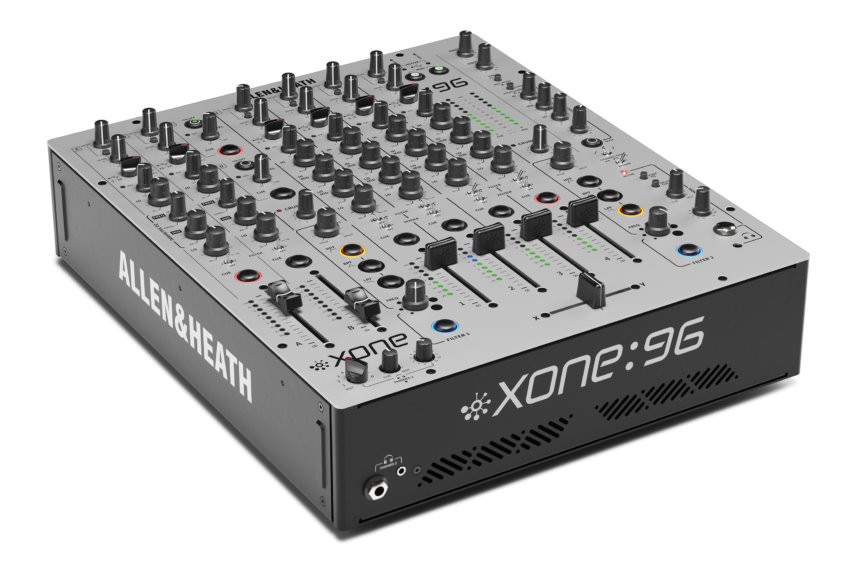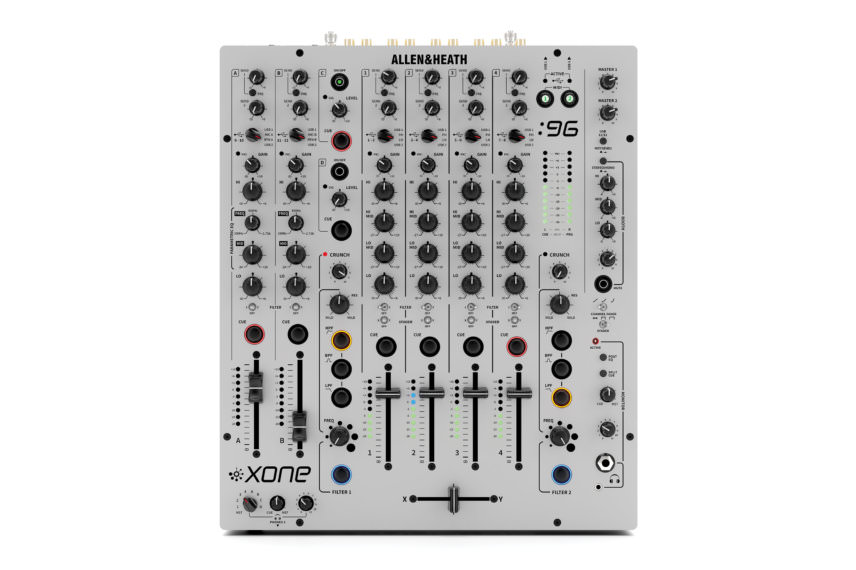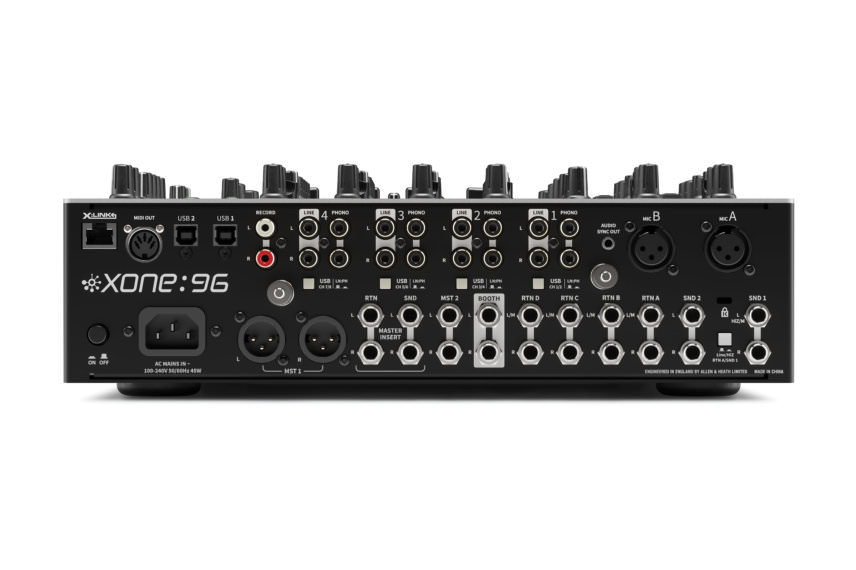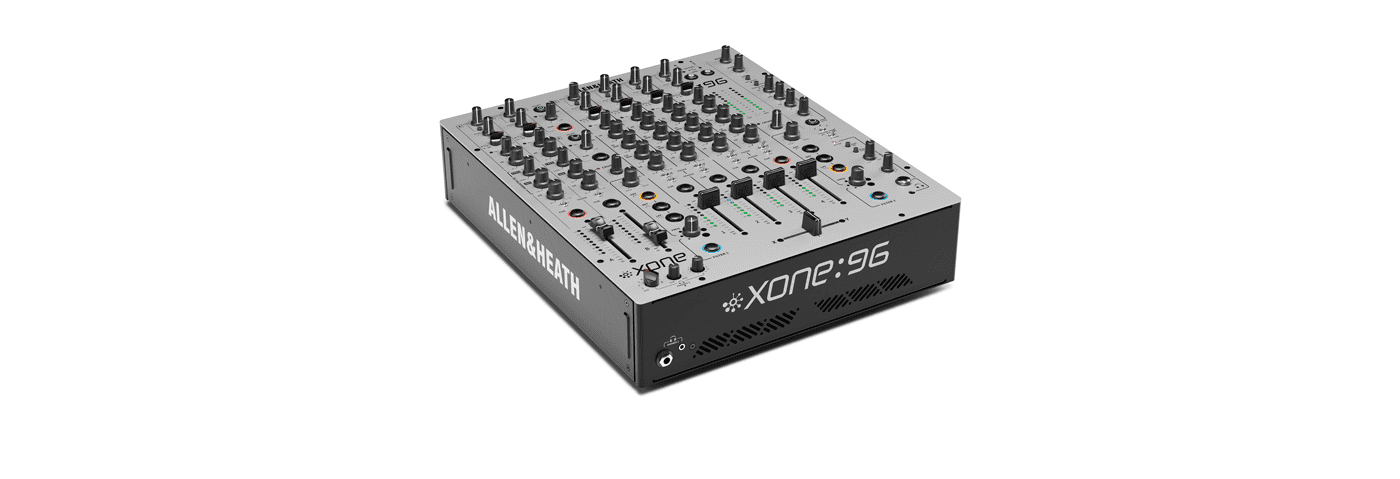15 years after its original release, Allen & Heath have recently released their updated flagship mixer: Xone. The Xone:96 should keep techno DJs happy for another 15 years. Declan McGlynn explains why.
The DJ mixer is an extremely personal component in the creative flow of any DJ – it’s how they funnel their music, shape their sound and create their style. As you contort your DJ identity, the instinctive muscle memory built up over those 10,000 hours evolves into a distinct bond. It’s a point Xone:92 architect and analogue mixer guru Andy Rigby-Jones is all too aware of, telling Resident Advisor in 2013: “Even small changes tend to freak people out … I wouldn’t say it’s been a victim of its own success, but because it has become a standard, it’s going to take very careful thought before we replace it.”
It’s no surprise then, that Allen and Heath waited 15 years to update their flagship Xone mixer. Where other brands followed and adapted to the mild and wild swings of the modern DJ’s technical requirements, the Xone:92 was always a simplified workhorse. It was fully analogue, meaning they didn’t have to update its converters as cheaper, better ones became available. It had zero FX, meaning their digital sound didn’t date. Instead, the Xone:92 focused on quality: build, sound and user experience.
The kind of DJ who’d request the 92 tended to be a more considered performer, less smash-and-grab, more frequency conscious and sonically sensitive. In fact, it was techno icon Richie Hawtin who was one of the early testers of the 92, and the one who convinced Allen & Heath’s Andy-Rigby Jones to add MIDI to the fully analogue unit. With techno’s emergence throughout the noughties as the genre-du-jour, with Hawtin and his label MINUS poster boys of the minimal sound, the 92 rose with it, becoming the techno DJs mixer of choice.
It wasn’t just a superficial association that elevated the status of the 92 – its four-band, asymmetric EQ encouraged sonic sculpting and allowed the user to subtly blend the frequencies of four tracks simultaneously, while the surplus of send and return options became another hallmark of the mixer, a further suggestion from Hawtin. And of course, the trademark feature and the one that united DJs of all styles and levels – the silky smooth filters.

More than a paintjob
So why now? What can A&H change that won’t upset the delicate balance, muscle memory and connection DJs develop with their favourite mixer?
A quick glance at the 96 and you’d be forgiven for thinking it’s nothing more than a paintjob – most of the additions are either subtle or completely invisible. The four main channels are still supported by two return fader channels, alongside two extra stereo returns labelled C and D, giving the Xone:96 an impressive eight total stereo inputs. The stereo return channels now have a new three-band EQ rather than the previous four-band of the 92, of which one band is parametric, similar to the MODEL1. It’s now also possible to route the return channels back into the filters.
Another look reveals that A&H have dropped the LFO feature in favour of a new ‘Crunch’ knob – a vague term that delivers something of a harmonic distortion effect that’s only active when the filters are switched in. Speaking of which, the nasty pop that once resided over the filter’s active switch is no more. While the Crunch feature is warehouse-techno-friendly, it probably won’t be used much by anyone outside that genre, however when running individual channels or instruments through the unit in the studio, it comes into its own, offering a deeply pleasing analogue saturator, especially on drums and basslines. It’s a shame it’s not MIDI controllable.
Other aesthetic additions include detailed of control over the mixer’s booth output, no doubt influenced by the MODEL1. With a dedicated three-band EQ, stereo and mono switch and a mute button for emergencies, it’s an extremely welcome addition, with booth monitoring one of the least consistent and yet most important aspects of a successful DJ set. Scooping out more sensitive mid frequencies from a badly performing booth monitor could only be a good thing for tired ears.

Quick and Easy
Finally for the external changes, the crossfader has been replaced by a mini innoFader, a welcome change for sure though the target market of the Xone won’t be those who cherish the crossfader above all else. It feels much looser than the 92, and the main volume faders are much tighter and smoother. There’s also a very welcome fader curve switch – this was a bugbear for many on the 92, as the curve was almost logarithmic. Now it can be easily switched to good old linear. There are new air vents at the side of the unit, which are key as this thing gets hot. There are small bumpers to ensure an air gap between the vent and a CDJ for example, but it’ll be interesting to see how this high running temperature affects the longevity of the unit especially in a sweaty club.
The biggest change to the Xone:96 is probably the one that explains its existence in the first place: the addition of USB ports. And that’s ports plural – the 96 boasts two individual USB B ports round back, each with up to 24 channels of audio: six stereo ins and six stereo outs. At a max resolution of 32-bit/96kHz it’s an extremely high fidelity addition, future proofing the mixer and maintaining the focus on high quality. For most, it’s the convenience of USB that will bring the most benefit – it’s now extremely simple to route the mixer through software such as Ableton Live to benefit from AU and VST effect sends.
In fact, it took less than 60 seconds between connecting the USB cable for the first time to having a CDJ signal running through Soundtoys’ omnipresent delay plugin Echoboy. With channel routing printed right there on the mixer’s chassis, there’s no trial and error or complex I/O setup. While carrying a laptop around as an elaborate effect machine might seem OTT, the real winners here are digital DJs who previously had to carry their own interfaces to gigs. Setting the 96 up as an external mixer for Traktor’s four decks was quick and easy.
With A&H adopting the digital world comes with it some interesting aspects that haven’t yet been addressed by the 96. One of them is clock – it’s not currently possible, for example, to sync a CDJ or turntable’s audio to your DAW or effects’ pedal clock. That is to say, the mixer doesn’t detect what bpm incoming audio is and use it in any meaningful way over USB or otherwise, like some other mixers do. In fact, A&H’s own PX5 mixer does exactly this, so it’s a surprise it didn’t make its way to the 96. We can only imagine it was another analogue-to-digital conversion stage that the designers weren’t comfortable with. However, there’s a hack online for anyone who wants to convert Pioneer DJ’s Pro DJ Link protocol into MIDI clock, which would solve the problem for CDJ users.

On the Xone:92, the LFO feature that’s now been dropped allowed ‘tap tempo’ clock via MIDI DIN Out. As it’s now been removed, there’s no clock being generated from the mixer itself, it’ll have to be provided by a laptop via USB.
There’s also a mysterious ‘Audio Sync Out’ 3.5mm that right now, according to Allen & Heath, is a “copy of the record out”. While the manual claims the port is aimed at ‘future products’, what those products are is not yet clear. Perhaps the BPM detection will be implemented via this port in the near future, which could also be theoretically implemented into Eurorack setups. A new clocking product on the way from Allen & Heath, perhaps?
Another surprising omission was any kind of digital audio connectivity. SPDIF I/O would have been an excellent feature and considering there’s already an ADA converter inside the mixer for the USB soundcards, it’s a shame that the connectivity wasn’t extended to SPDIF.
Despite USB bringing 24 extra channels, the feature hasn’t replaced the physical quarter-inch send and return ports on the back of the unit. In fact, there’s even more ins and outs than on previous versions,
Monitoring has been simplified by adding a second cue output with up to nine signal routing options, including the four return channels. Speaking of monitoring, it’s now possible to ‘latch’ the cue buttons, meaning you can activate more than one at the same time. The default setting remains ‘auto-cue’, where any cue is deactivated when another cue switch is triggered, but it can be changed to ‘latch’ with a few button combinations and the current setting is remembered when the mixer is powered off.
The Sound & Conclusion
You’re probably wondering why we’ve left it to the end of this review to discuss the most important part of any DJ mixer – the sound. Well, because it’s not changed too much from the Xone:92 in that it’s rich, full and has a depth that instantly encourages reaching for the filters and EQ. As Jones already alluded to, when the 92 was finally updated, it’d have to adhere to the high expectations of current power users while still nudging the unit into the 21st century. They’ve done exactly that, making what was an already flexible mixer into a routing powerhouse, retaining the high-quality sound, finish and build in the process. If the price tag of £1,599 might seem steep, but it’s still cheaper than a DJM900nxs2 and has serious potential in the studio as well as the booth, to help justify the outlay.
Losing the on-board clock seems like a fair sacrifice for the extra USB functionality and the extra ins and outs the 96 has added. This is a mixer for the seasoned DJ who’ve carved out their own, unique and specific style – the kind whose tech rider also includes threats, and for good reason. The art of DJing is deeply personal and it shouldn’t be compromised – the Xone:96 reflects that ethos.
The Verdict
Price: £1,599
Purchase: Allen & Heath Xone:96
The Final Word
The art of DJing is deeply personal and it shouldn’t be compromised – the Xone:96 reflects that ethos.
